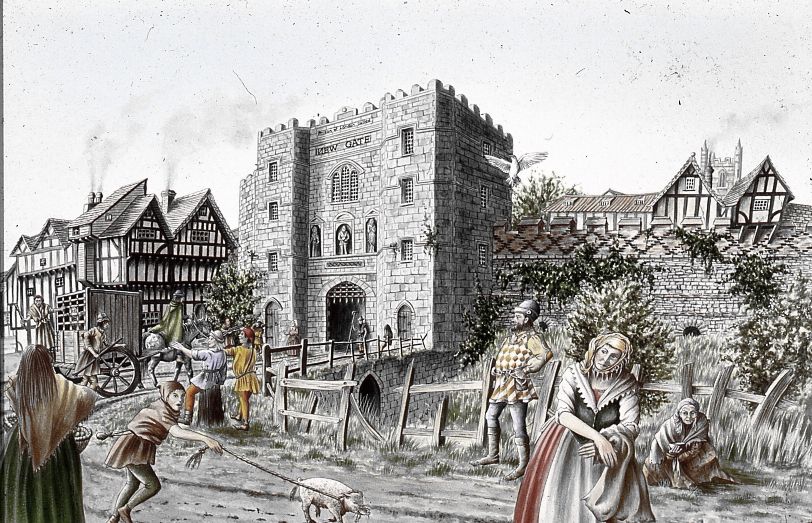Here are listed the public guided walks and tours I have currently got in my diary. I will be adding others all the time.
Jane Austen’s London Anniversary Walk 11.30am Sun 6th Apr 25 To book
Chaucer’s Medieval London Guided Walk 2:30pm Sun 6th Apr 25 To book
Chaucer’s London To Canterbury Virtual Pilgrimage 7.30pm Friday 18th April 25 To book
Roman London – Literary & Archaeology Walk 11.30am Sun 27th Apr 25 To book
Tudor London – The City of Wolf Hall 3:00pm Sun 27th Apr 25 To book
Myths, Legends, Archaeology and the Origins of London 11.30am Sun 25th May 25 To book
The Decline And Fall Of Roman London Walk 3pm Sun May 25 To book
The Peasants Revolt Anniversary Guided Walk 3pm 7th June 25 To book
Jane Austen’s London Anniversary Walk 3pm Sunday 13th July 25 To book
Charles I and the Civil War. Martyrdom Anniversary Walk Jan 30th 2026 To book
For a complete list of my guided walks for London Walks in 2025 look here
As Mad as a March Hare March 28th
The expression ‘Mad as a March Hare’ comes from the displays of hare boxing that takes place as the Hare mating season begins. And no, it’s not the male March Hare fighting in the spirit of romantic rivalry. It is the female hares fighting off unwanted attention from the males. Hares are solitary creatures, and the mating season is, perhaps, particularly difficult for them. The Country File website has more on the subject. www.countryfile.com
Not only March Hares but March Kittens too
There are also March Kittens and March Chickens. Edward Topsell in his ‘History of Four-footed Beasts‘ 1607 says the best Kittens to keep are those born in March. ‘The Closet of Sir Kenelm Digby Opened‘ 1669 says:
‘Keep a black cock hatched in March as a protection against evil spirits: his crowing terrifies them.’
He also give a recipe for Cock Ale:
Eight gallons of Ale, a boiled March Cock, four pounds of stoned Raisins, half a pound of dates, nutmegs, mace. Beat the ingredients in a mortar, add to two quarts of Sherry. Add to the ale. Stop it in a container for 6 or 7 days. Bottle it, drink after a month.
Very weird. I challenge my readers to try it and let me know how it goes?
Was the March Hare Sacred?
But its not only March Haries, because the hare itself was a sacred animal. It was sacred to Aphrodite because of their prodigious ability to have offspring:
‘For you know, I imagine, what is said of the hare, that it possesses the gift of Aphrodite to an unusual degree. At any rate it is said of the female that while she suckles the young she has borne, she bears another litter to share the same milk; forthwith she conceives again, nor is there any time at all when she is not carrying young.’
Classical Texts Library. Philostratus the Elder, ‘Imagines’ Book 1.1-15 c 3rd Century AD. Translated by Arthur Fairbanks.
Divine Celtic & Neolithic Hares
Research reported by Exeter University suggests that hares were worshipped in pre-Roman Britain. Julius Caesar wrote:
“The Britons consider it contrary to divine law to eat the hare, the chicken, or the goose.”
‘The Battle for Gaul’ Translation by Wiseman, Anne, Wiseman, T. P. Published by Penguin Random House, 1980 ISBN 10: 0701125047 (TP Wiseman was my professor for Classical Studies at Leicester University).
In Neolithic Ireland hares were found buried with human remains at the Neolithic court tomb at Parknabinnia.
March Hares, Easter Bunnies, & Witches
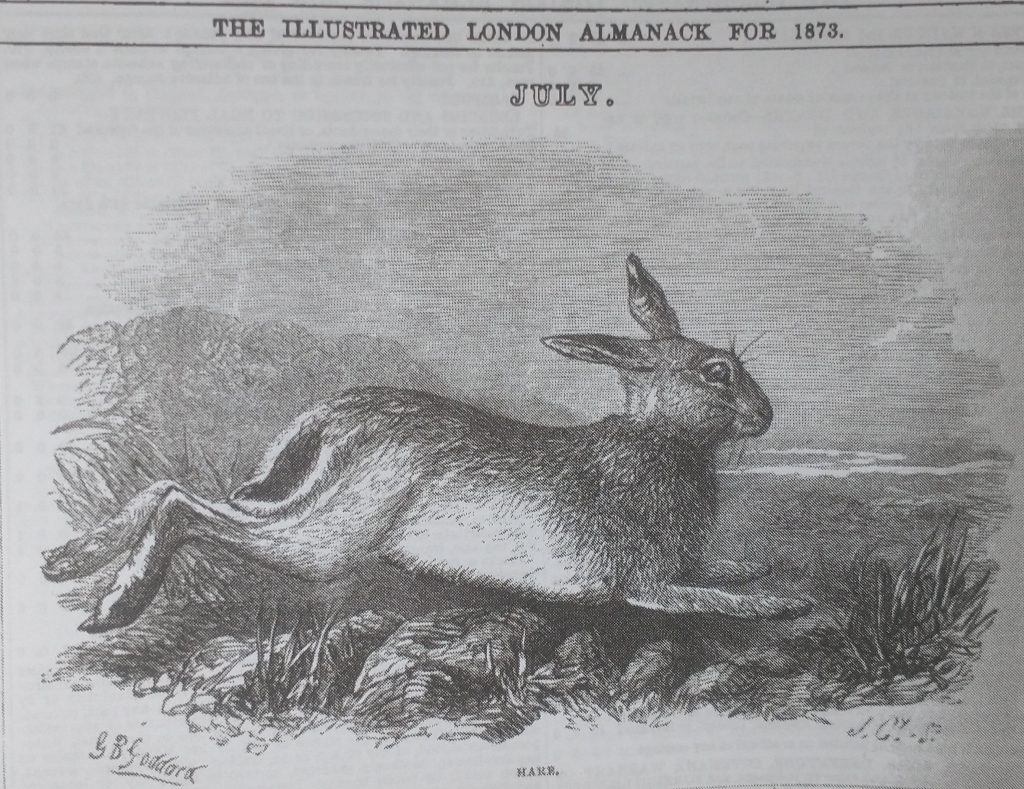
Hares are thought to be the original Easter Bunny. But finding good evidence before Germany in the early modern period is difficult. There is a tradition that witches can be scared away at Easter. Exactly, how this works is not at all clear to me. But it has been said that witches could take on the form of a hare. So eating Hare Pie at Easter help rid the land of the witches.
You could have a jugged hare. Jugging is cooking a whole animal in a container over water. Follow this link for a recipe for jugged wild hare. Remember, you are not allowed to shot or trap them on a Sunday or on Christmas Day! For a discussion of hares and folklore, click here:
Hare’s Feet Totems
A jointed hare’s foot was considered very lucky and a remedy against gout, stomach pains and insomnia. (The Perpetual Almanack of Folklore by Charles Kightly, which I have used several times in this piece.) You can buy one on eBay. (Don’t click the links, it’s not an advert but a picture of an advert). I remember friends having rabbit feet which they carried around with them often on key rings?

Please look at my January Post of Rabbiting January-19th-kalendar-of-shepherds/
First published March 28th 2023, revised 2024, and 2025
March 25th Feast of the Annunciation

Today, is the anniversary of the conception of Jesus Christ. 9 Months before Christmas. I told some of this story yesterday which was St Gabriel’s Day, there is a little bit of repetition but hopefully the extra detail makes it worthwhile!
The picture above is by Duccio, from Sienna in Italy. It shows the Archangel Gabriel bringing Mary the news that she is to give birth to the Son of God. It is in the Sainsbury Wing of the National Gallery. I chose it to represent March 25th as it has a special meaning to me. When I started taking groups to the National Gallery this was the second painting on my tour with its narrative thread on the development of perspective. I had been reading a book on the subject by David Hockney.
The painting shows that Duccio does not understand single-point perspective. But then, no one could do perspective at that time in Europe. This skill was lost following the Roman Period. But at the beginning of the 14th Century, painters like Duccio from Sienna, and Giotto from Florence, were groping towards more realistic representation.
You might say they wanted a more human depiction, in which events are shown in spaces that are trying to look real. Filled with more realistic looking people and beginning to show on their faces real emotions. Previously, the Byzantine style produced iconic, storytelling images, that were somewhat cartoon-like rather than realistic. Here, is a detail from one such. There is little attempt to make the encounter seem real, in a real space between real people. But it does tell the story effectively.
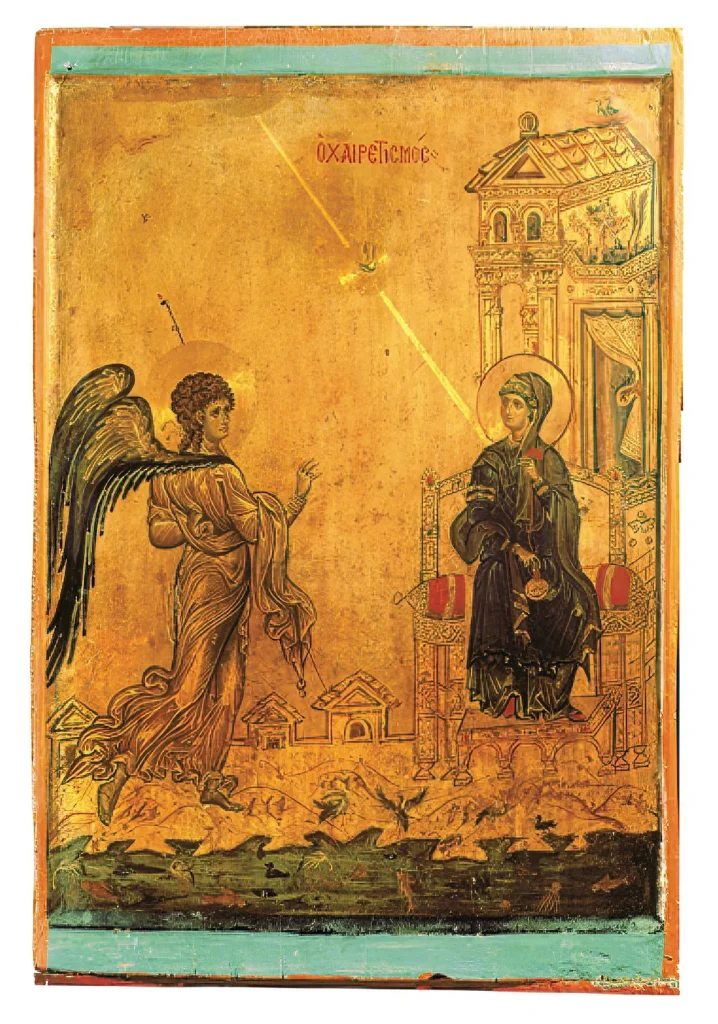
Now, look at the Duccio, he uses the arcading at the top of the painting to give an impression of this being an encounter in a real space. The Archangel Gabriel is moving through that space decisively. This is not just a picture with a story, it shows Duccio’s interest in capturing a fleeting but incredibly emotional moment. It happens to be the most important moment in the history of the world (from a Christian view point), the moment that the son of God is conceived as a human.
Gabriel is striding purposefully towards Mary, who has come out of her house to see him. He is just telling her ‘Hey, you are going to give birth to the Son of God.’
She looks overwhelmed, holding her arm protectively towards her. ‘What me?’ she might be saying. But she is also pointing at the Bible where this moment in time is predicted by Isaiah. Their faces are quite realistic, Mary is clearly emotional.
Also, if you look at Gabriel’s feet he is quite well grounded unlike many other medieval paintings, where people often seem to be floating above the ground. Mary, too is firmly, anchored, although you cannot see her feet.
It is by no means ‘perfect’ because they don’t yet know the rules of perspective. Neither have they discovered they could use lenses to create ‘photorealistic’ portraits. But they are searching for methods that can bring spaces and people towards realistic life. It mirrors a humanistic trend to see Mary not as a sort of Goddess, but as a real mother.
Above the arcading can be seen a small sphere of blue sky from which emanates several ‘rays’ and a tiny Holy Dove. As I told the story, the rays are showing the moment of conception coming from Heaven to her womb which is hinted at by the red of her dress. The National Gallery commentary, which you can read here, suggests ‘The conception takes place at the moment she hears the words, which is why a tiny white dove, representing the Holy Ghost, flies towards her ear‘.
This made me stop and think – the tiny dove is heading to her ear is it? Really? Why? Gabriel is the messenger saying the words, the words head to the ear. The Holy Dove is a symbol of the Holy Spirit, part of the Trinity of Father, Son and Holy Ghost. Its role, in the painting, is to show that God is the Father. So why, would the Holy Spirit enter by the ear?
I have been using a ruler to try to see if the National Gallery are right! It’s difficult to be sure with a reproduction. but my ruler says the rays from Heaven are neither heading to the ear nor directly to the womb but in the general direction of her body. If they are right that the rays from heaven are heading for her ear, then is this rather the moment she is being told she will conceive rather than the moment of conception?
But the National Gallery text accepts that it is the moment of conception that is shown. So, I’ve looked at Luke 1:26-38:
‘Do not be afraid, Mary, for you have found favour with God. And now, you will conceive in your womb and bear a son, and you will name him Jesus.‘
On first reading he is telling her she will conceive, but reading it more carefully he is saying ‘now, you will conceive’. So Duccio is paying very careful attention to the Gospel. By the time Gabriel finishes his sentence she will have been impregnated by the Holy Dove. Looking at other paintings of the Annunciation the rays from heaven/Holy Ghost head generally towards the virgin, sometimes to her head, nothing suggesting the ear.
I’ve included a 19th Century Rossetti painting because it is so beautiful. It shows a lilly representing purity, instead of the rays, pointing to Mary’s womb.
By the way look at the feet in Rossetti’s painting. This is an early Rossetti painting, who was a poet and I don’t think he yet had the skills to ground feet. But he takes advantage of it in this case and disguises his ineptitude by giving Gabriel fiery feet. Subsequently, Rossetti concentrated on paintings of women from the waist up. Since, first writing this, I have visited an exhibition of Rosetti’s drawings, and they show a very capable draughtsman.
For more on March 25th. My post shows that, in fact, from a Christian perspective, March 25th is the most important day in history.
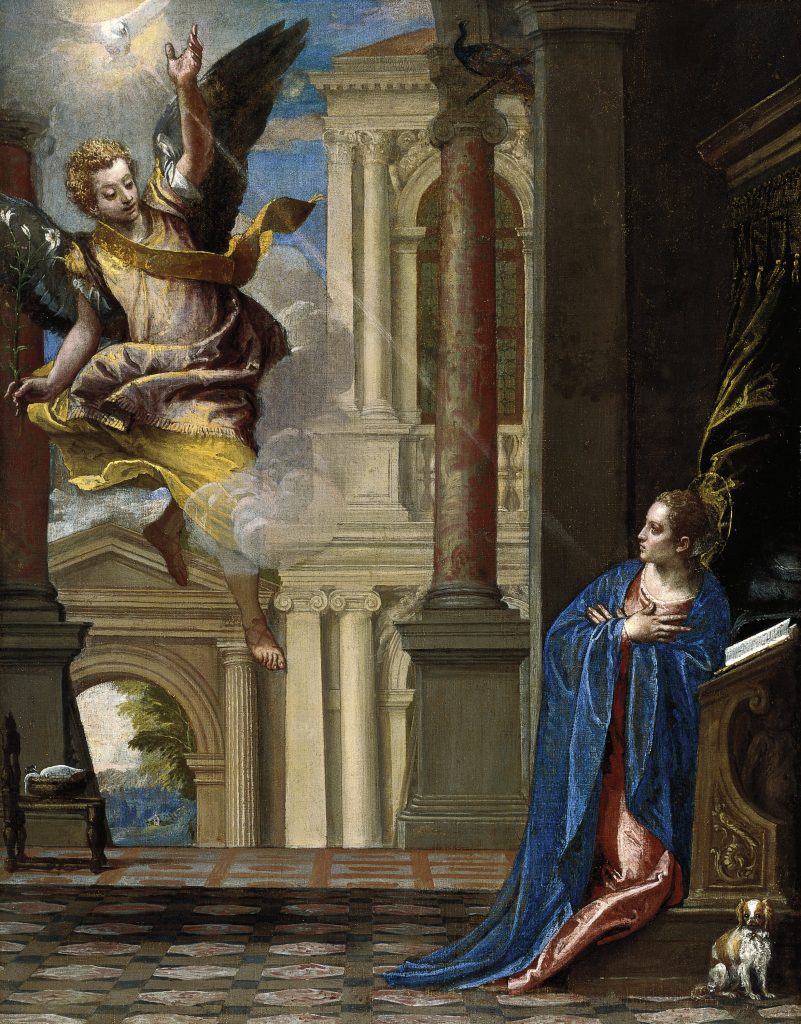
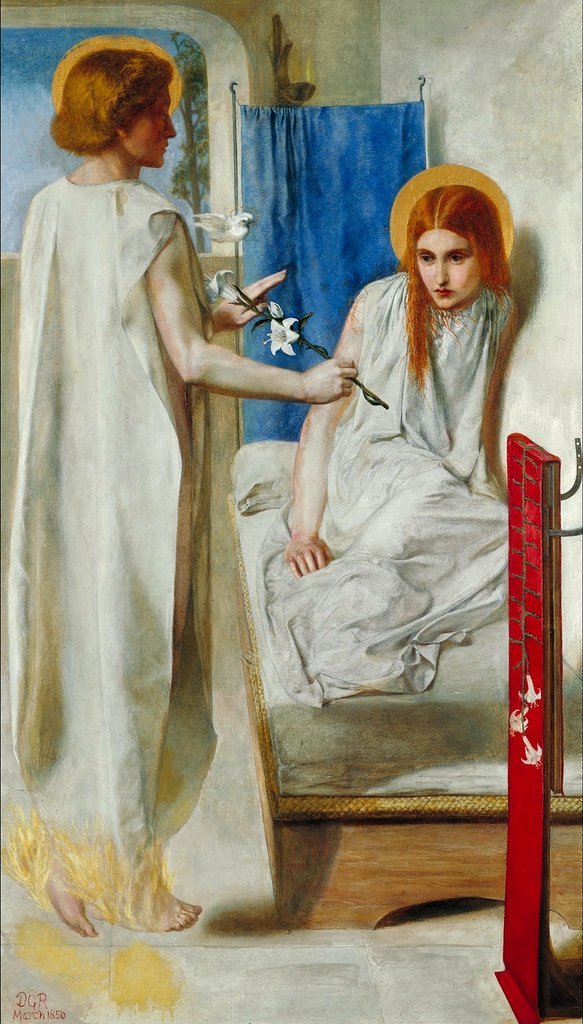
First published 2024, revised 2025
The Beginning of the Universe as We Know It; Birthdays of Adam, Lilith, & Eve; Conception of Jesus, Start of the Year March 25th

This is my second most popular post. March 25th is the Annunciation—the day that the Archangel Gabriel tells Mary she is pregnant. (to see some very fine paintings of this meeting, look at my other March 25th post march-25th-feast-of-the-annunciation/
March 25th is also the anniversary of the birth of Adam and Eve (and Lilith); the death of Jesus Christ; the anniversary of the Immolation of Isaac; the Parting of the Red Sea; the Fall of Lucifer; and, (until 1752 in the UK) the beginning of the Year.
Of course, it isn’t. Or to put it another way, no one can, or ever could, prove any of these dates except the last one. So what they speak to is the way the Church saw the world as logically structured by God. Christian thinking about the year, the world, the universe, creation, developed over many years and took influences from many cultures. It is also very complicated to work out the sequence, so I’m going to summarise what I know (or at least what I think I know).
Christians chose Christmas Day as the Birthdate of Jesus probably because it was a prominent birthday already shared with several Gods. Particularly, Mithras and Saturn. It was approximately at Solstice, the beginning of the Solar Year, and close to one of the main festivals of the Roman World, the Saturnalia. So it made it easier for new converts who could retain elements of their festivals after conversion.
December 25th might have been chosen by the pagan religions because it is the time when the Sun begins to rise further north each day. The days stop shortening and start lengthening, light increases with the promise of warmer weather and budding plants.
So, Jesus was born on/or around the Solstice, so he must have been conceived approx. 9 months earlier. This is approximately at the Spring Equinox.
Ah, you are thinking! But today isn’t the equinox. Surely God doesn’t do approximately?
I have always thought that the 4 or 5 days difference between the Solstice, the Equinox and the Christian festivals was down to the fact that the Calendars were not well coordinated with the actual movements of the Sun (because the Sun does not circle the earth in 365 days, or in 365 and a quarter days, but 365 days, 6 hours, 9 minutes which makes lunar Calendars hard to align with the Sun).
But when I first wrote this a sudden revelation dawned upon me which will be revealed in the next few paragraphs.
So, God sends his Son to save the human race. God is a logical being, so she would send her Son at an appropriate time. If the Child is born at or near the Solstice, which is an appropriate time for the Son of the Creator, then conception 9 months earlier, March 25th, is near the Equinox. This is the beginning of Spring. For many people, Spring is a new beginning, for example, the Anglo-Saxons saw Winter as the death of the year, and Spring as the young Year. It all makes sense.
So to the Creation. God, having a free choice, would have created the world at the beginning of Spring. In fact, if you think about it, God creates everything necessary for life at the creation in 6 days. So as soon as it has all been created and put together it is bound to immediately spring into new life. The first season must, therefore, be Spring? Right? So March 25th.
This gives a nice symmetry with Jesus’s Life. Conceived on March 25th, born December 25th, and died 30-40 years later, according to the Church, on March 25th. (the only other famous person I know born and died on the same day is William Shakespeare).
Easter, when Jesus is martyred, isn’t March 25th I hear you saying. But remember, Easter is a lunar festival, so its date varies each year. Births and deaths, on the other hand, are fixed to the Solar Calendar. Therefore the Church chooses March 25th as the most appropriate day to pin the death of Jesus, on the anniversary of his conception and the anniversary of the creation of the Earth. I am guessing that this is also the preferred date for the Day of Judgement.
It is also the Birthday of Adam, and his first wife Lilith (or so some say), and Eve. More about Lilith below. I had thought this date was just one of the parallels that the Church liked, Jesus and Adam born on the same day. But, I have just worked out why Adam is born on March 25th, and why these dates are not the Equinox, March 20th but March 25th, which has been bugging me.
Let’s go back to the Beginning of Creation.
The Creation, as described in Genesis, has the following sequence of Seven Days, beginning with the Equinox March 20th. I have added dates to the 6/7 day sequence of Creation:
- Day 1: Light – March 20th
- Day 2: Atmosphere / Firmament – March 21st
- Day 3: Dry ground & plants – March 22nd
- Day 4: Sun, moon & stars – March 23rd
- Day 5: Birds & sea creatures – March 24th
- Day 6: Land animals & Adam, Lilith and Eve – March 25th
- Day 7: The Sabbath of rest – March 26th
- For more information www.bibleinfo.com
So there you have it! Adam, Lilith, and Eve were created on Day 6 with the Land Animals – March 25th. Jesus conceived, also on this date, and so 9 months later is born on December 25th. It all makes sense, and aligns the Christian year fully with the Solar Year.
And that, dear Reader, is the very first time anyone has been able to explain to me why Christmas is not at the Solstice, and why the Annunciation was not at the Equinox. Maybe you all know this, but it is very exciting to work this out for myself. And believe me, I have done a lot of reading about calendars and not spotted an explanation.
When was the Creation?
According to the Anno Munda‘s arrangement of the Year, the world was created 5500 years plus 2023 years ago so 7523 Before the Present. And it was supposed to have ended in 600AD, 6000 years after the Creation. So, they got that wrong.
Dionysius Exiguus replaced the Anno Mundo year with the AD/BC system in the 6th Century AD).
Beginnings of the year
I was thinking about the beginning of the year. The Celts chose October 31st, Julius Caesar chose January 1st, other cultures have other dates, and the Spring Equinox is another choice sometimes made. The Church and Dionysius Exiguus choose March 25th, although secular society also recognised the claims of January 1st. Britain kept to March 25th until 1752 when we adopted the Gregorian Calendar. But people like Samuel Pepys celebrated New Year’s Eve on 31st December. So January 1st was the New Year, but the year number did not change until March 25th. So King Charles I thought his head was being cut off on January 30th 1648; while history books will tell you it was cut off on January 30th 1649. Same day, different reckonings.
December 31st/January 1st is essentially a Solstice New Year Festival. And I have, previously, used the difficulty of keeping calendars as to why these days has slipped out of alignment with the Solstice. But, today I realised that it is as likely that the reason is the Solar/Lunar nature of our time keeping. The year, and its festivals, is largely arranged around the Solar Cycle. But our weekly and monthly cycles are derived from the Moon.
January 1st is the Kalends of January as the Romans would have called it. This day the First New Moon after the Winter Solstice. So, January 1st is a slightly misdated Solstice Festival it is a Festival celebrating the first New Moon of the New Year!
Over time societies give up trying to sync the lunar and solar calendars. Roman and Christian cultures gave up and fixed the moon months, completely abandoning any attempt to keep the months to the actual lunar cycle. This is our current system, in which only Easter remains a true to the moon festival, much to our perennial confusion.
Maybe you all know this, but I’ve learnt a lot in writing these two posts.
Lilith
The April 2023 Issue of ‘History Today’ has a short piece called ‘The Liberation of Lilith’ which suggests that the story of Lilith, a figure from Jewish Folklore, is first attested in a Medieval satirical text called ‘The Alphabet of Ben Sira’. The story goes that Lilith is created using the same clay as Adam. Adam then demands she lies below him during sex. She refuses, saying that they are both made from the same stuff and, therefore, equal. Adam refuses to accept this, and so Lilith leaves the Garden of Eden. So the story goes.
The story of Lilith, Sarah Clegg suggests, is one of a series of similar stories found around Europe and Asia. And Clegg assumes that it is gradually modified to make Lilith a demon who will kill babies unless the names of three angels are spoken out loud.
The story survives as a charm to keep babies safe, and perhaps to remind people of equality among the sexes. But this causes problems for, OK, let’s call them out, the Patriarchy. Lilith cannot be equal to Adam so she becomes a monster, not made from the same clay as Adam but from the scum and waste left over from Adam’s creation. I imagine the story then went on to propose that God creates Eve from Adam’s rib, and so she is created from Adam, and is, therefore not equal, but subservient to him. Lilith is now a significant figure in feminist folklore circles.
I wrote about more about eras and ages in my post which you can see her: Greater Cycles and the Six or Seven Ages
Attached to the watercolour of Lilith by Rossetti (at the top of the page), was a label with a verse from Goethe‘s Faust as translated by Shelley. (Wikipedia)
“Beware of her fair hair, for she excells
All women in the magic of her locks,
And when she twines them round a young man’s neck
she will not ever set him free again.”
The model is Fanny Cornforth, Rossetti’s mistress. He painted another version a few years later, but the model in that is Alexa Wilding. His models are arguably more interesting than the man himself and include: Elizabeth Siddall, Jane Morris and Fanny Cornforth. Christina Rossetti, his poet sister, modelled for Rossetti’s painting, Ecce Ancilla Domini which you can see here.
For more on the Annunciation, look at my other March 25th post here.
I think I might have enough material to begin my own Cult.
First Written 25th March 2024, revised 2025
St Gabriel’s Day March 24th
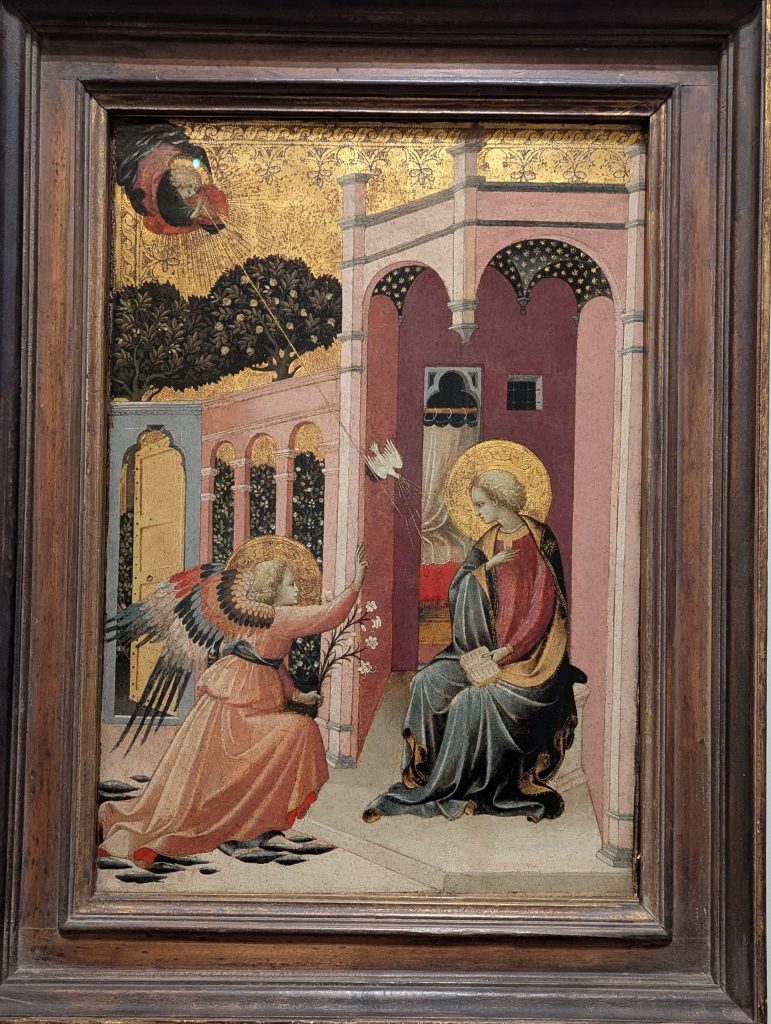
Today, is St Gabriel’s Day, or rather it was. Because the Church amalgamated the Archangel’s Celebration onto St. Michael’s Day, or Michaelmas on October 11th. It is now St Michael and the Archangels Day. You can read all about this in my post here.
Angels and Archangels are a complex and disputed subject. Angels appear in many religions in some guise or other. But they sit in a difficult place in a modern monotheistic religion. Does an omnipotent God need whole levels of messengers and intermediaries? And Angels and their heavenly host are they semi-divine demigods? I will devote a whole post on the heavenly host soon.
St Gabriel’s Day, is the eve of the Annunciation. The day he announces to the Virgin Mary that she is pregnant with the Son of God. The most important news the world has had, if you believe in the story. But more about that tomorrow. Tomorrow, March 25th is, arguably, the most important day in the history of the Universe. It is:
The Birthdays of Adam, Lilith, & Eve
The day of the Conception of the Son of God
The first day of the Year until 1752
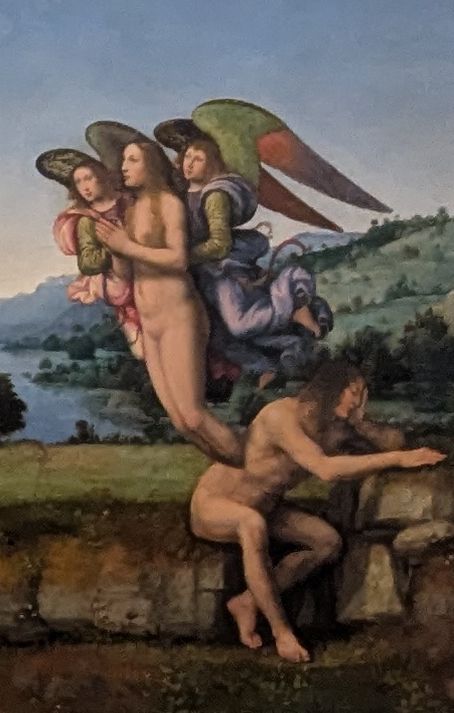
Tomorrow’s post is also my second most popular post, and so you can follow those links or wait a few hours for my updated 2nd most popular post of the Almanac of the Past.
St Gabriel’s Day, the National Gallery, the Courtauld, Italian Food and Mrs Malaprop
My interest in St Gabriel began when I was Course Director for the Road Scholar programme ‘London in Depth’. What I love about working for Road Scholar was the opportunity it gave me to spread my didactic wings. So, I could order a specialist to guide my group in the National Gallery or do it myself. I chose the vainglorious choice. But I loved standing in front of a painting in the Sainsbury Wing talking about the renaissance development of perspective with a Giotto behind me, a Masaccio on the horizon and Duccio’s Annunciation in front of me. I created the narrative myself but what a thrill to speak about a painting with such, perhaps unjustified, confidence? I was a mere Archaeologist after all.
The tour went on via Michelangelo, Leonardo, Titian, Holbein and wound up with a Canaletto of two. I did it for maybe 10 years. On one tour, I finished, went for lunch with a nagging worry in my head. I mulled it over. Had I really stood in front of a precise work of architectural perspective, and enjoined my group to look at the simple way Cannelloni had rendered the Grand Canal?
I had. I have always had a bit of Mrs Malaprop in me. Named after a character in the Rivals by Sheridan. Shamed, but the worst of it, is that there are so many Italian Painters (and footballers for that matter) who sound like food. And the fear of repeating that faux pas, lives with me, to this day, whenever I go with a group to any Stately Home, not only will there be a Canaletto, but also there is bound to be a Panini. When I tell me group ‘Look at the Panini’ I have a moment’s fear that I have surely got it wrong again!
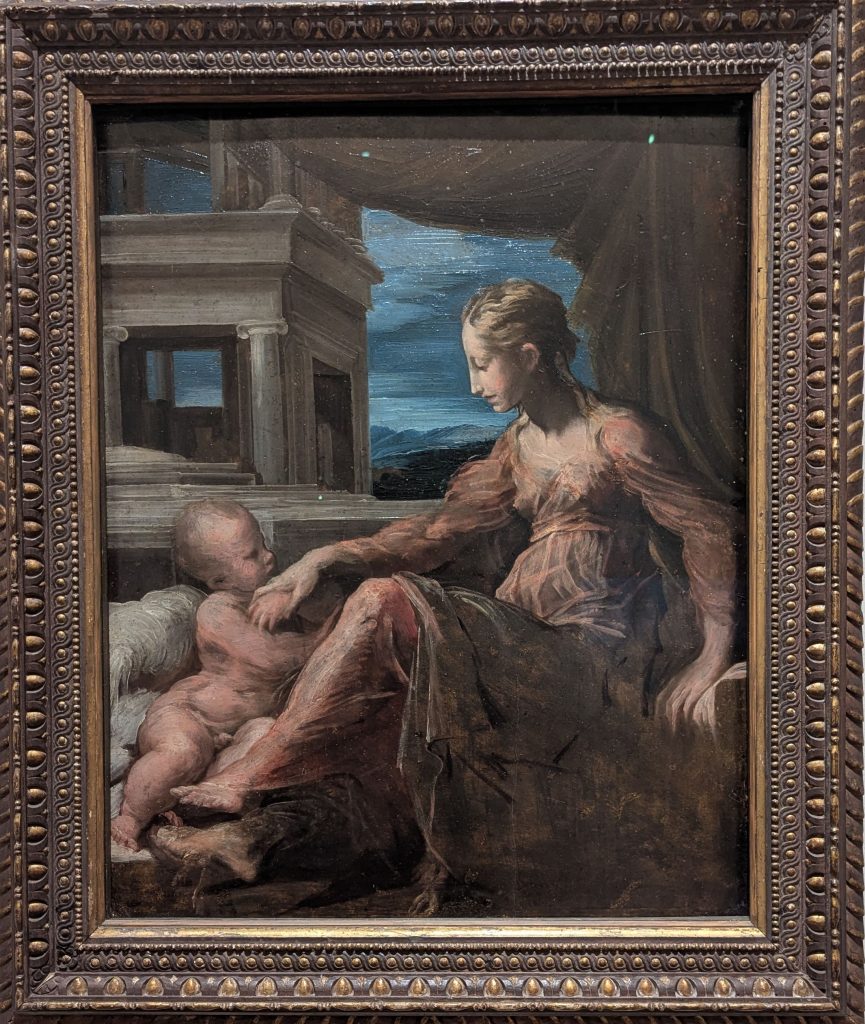
So, yesterday, I was in the Courtauld, enjoying the pictures, the old rooms of the Royal Academy and photographing paintings. Looking for something for St Gabriel’s Day or anything else that might be useful for the Almanac of the Past? Out of the corner of my eye, in a Renaissance room, I spotted a painting that seemed out of place. A stunning painting but the woman looked modern or at least 19th Century, and the colour palette very subdued and certainly not like most Great Masters. I looked at the label ‘Virgin and Child’. Parmigianino. Whose real name turns out to be Mazzola. I rest my case.
It’s a great gallery! Do visit.
On This Day
1603 – Queen Elizabeth I died in the small hours of the morning of March 24th. Sir Robert Carey immediately set off on his horse to be the first to tell James VI of Scotland he was now King James I of England.
He left around 9.30 got to Doncaster by night time. Next night he got to his own house in Witherington in the Borders Country, Next day he left for Edinburgh but fell off his horse. So didn’t get to Edinburgh until James was about to go to bed. He was carried to the King’s Chamber and knelt, saluted him by his new title “England, Scotland, France and Ireland’.
First published on March 24th, 2025
Campden House Fire Sunday March 23rd 1862
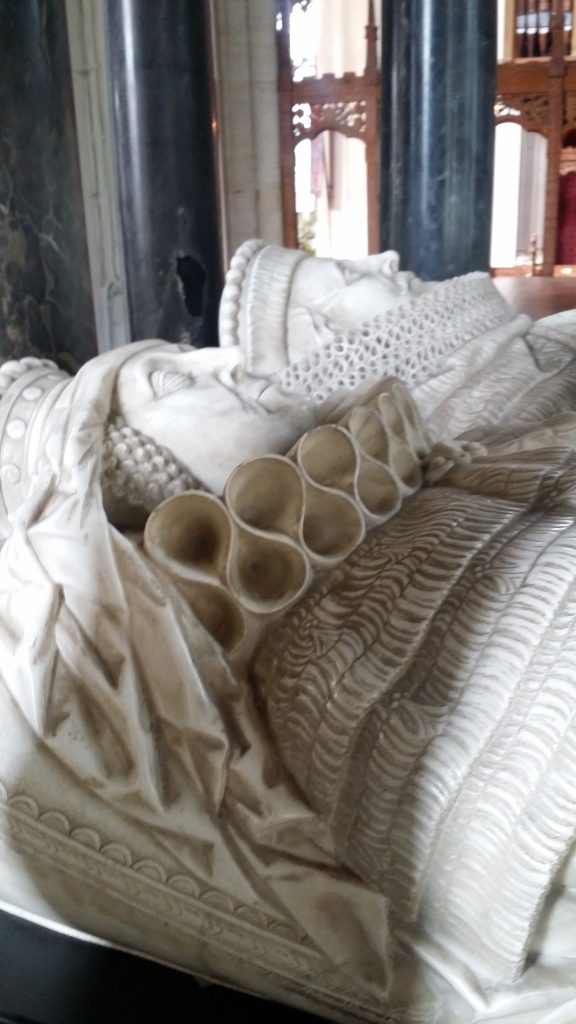
This anniversary commanded my attention because I spend a few weekends each summer in the Cotswolds. There I see the ruins of Campden House in Chipping Campden. This was was burnt down in 1645. So, when I read about the burning down of Campden House in the 19th Century, it had to be another one. And it turns out there is one in Kensington, London, and another in Chipping Campden. Both were built for Sir Baptist Hicks, Viscount Campden.
Baptist Hicks Rise to Aristocracy
Baptist Hicks is an example of the flexibility of the British system of aristocracy. Hicks was a commoner, the son of a wealthy Mercer from Cheapside in the City of London. His mother is said to have been a moneylender. But when her husband died, she was resourceful enough to take over the business. She made a success of it and eventually passed it on to her son. The family shop was on the corner of Cheapside and Soper Lane, near the Great Conduit. It was signposted by the sign of the White Bear.
Soper Lane was in the Cordwainers Ward. It was the haunt of soap makers and shoemakers (cordwainers as they were called). But Cheapside, itself, was the home of Goldsmiths and generally a wealthy area.
Hicks was educated at Trinity College, Cambridge and at the Inner Temple in London. But despite the rudiments of an education as a lawyer, he chose to continue in the family business. He supplied members of the Aristocracy with silk, velvet, taffeta, and other expensive fabrics. He rose to be Mercer to Queen Elizabeth I in 1598, and supplied James VI of Scotland. Indeed, he provided velvet, damask, and satin for the coronation of James 1st on 25 July, 1603.
As his business grew, he was able to lend large sums of money to the aristocracy and the King. He was duly knighted in 1603. He was still running his shop but was elected as an MP. Now, Hicks needed a country estate to transition to the aristocracy. So, in 1608, purchased the manor in Chipping Campden.
Baptist Hicks and Campden House, Kensington
At about the same time, he won a game of cards with Sir Walter Cope of the Strand. Cope was engaged in building himself a mansion (Holland House) on top of the Hill in Kensington. Hicks won a few acres of the Estate at cards. He asked Cope’s architect John Thorpe to design him a house, which Hicks also called Campden House. Thus, Kensington became fashionable, and Campden Hill got its name. Campden Hill continues as Notting Hill.
After Baptist Hicks death there were many tenants of the house. One was Princess Anne before she became Queen Anne. Also Lady Burlington and her son, Richard Boyle, who became Britain’s first Palladian Architect.
Hicks was made a Baron in 1620 and Viscount of Campden in 1628. (a viscount is 4th in the ranks of aristocracy, being below an Earl and above a Baron). He died in 1629. He was buried in a very impressive marble monument in St James Church, Chipping Campden shown above.
Campden house, Chipping Campden

After his death, the house in Chipping Campden was held by the Royalists in the Civil War. But the Parliamentary Army forced the King’s men to retreat towards Oxford. Prince Maurice ordered the house to be burned down. All that survives of the property are two banqueting houses, and the entrance. All show what a fine building it was.
To read my post on the infamous Chipping Campden Murder follow this link.
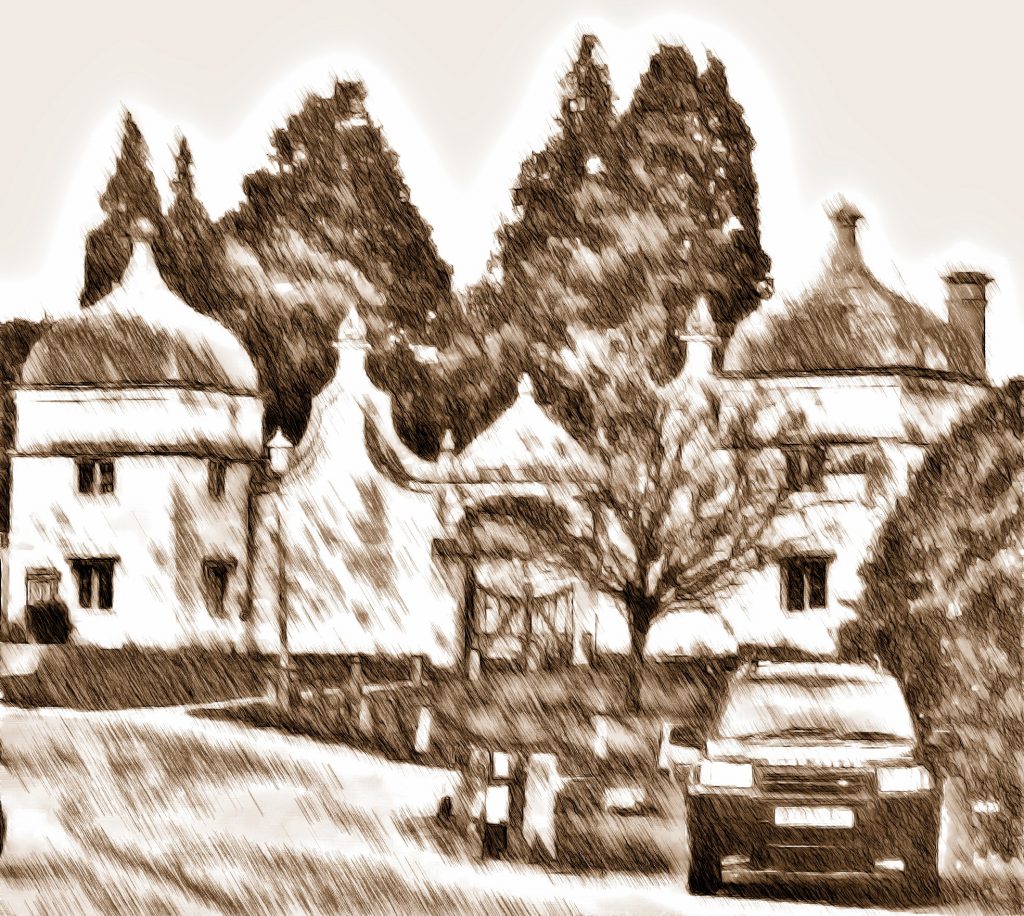
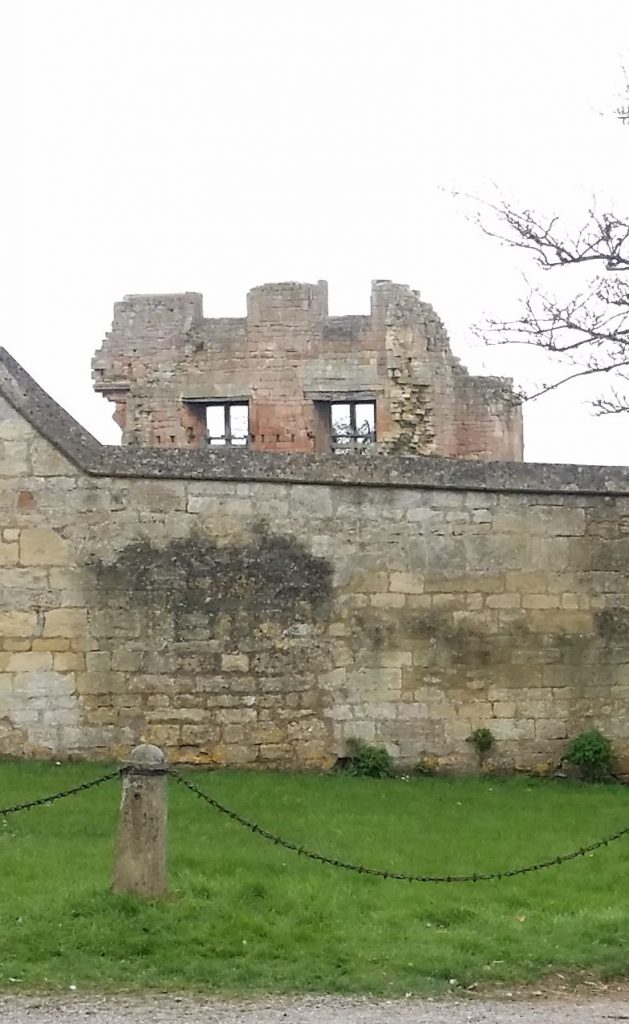
The Fire at Campden House, Kensington.
The fire at Campden House on 23rd March, 1862 gutted the building. It is really well described in this post which I recommend you read. Briefly, a neighbour saw the fire. A fire engine was summoned, but before it could arrive a servant was seen at a window. Her son tried to push past her, and she fell out of the window but survived. When the fire engine arrived, it was too late and the house and its wonderful contents were destroyed. The owner was sued by the Insurance Company for fraud, but they lost the case.
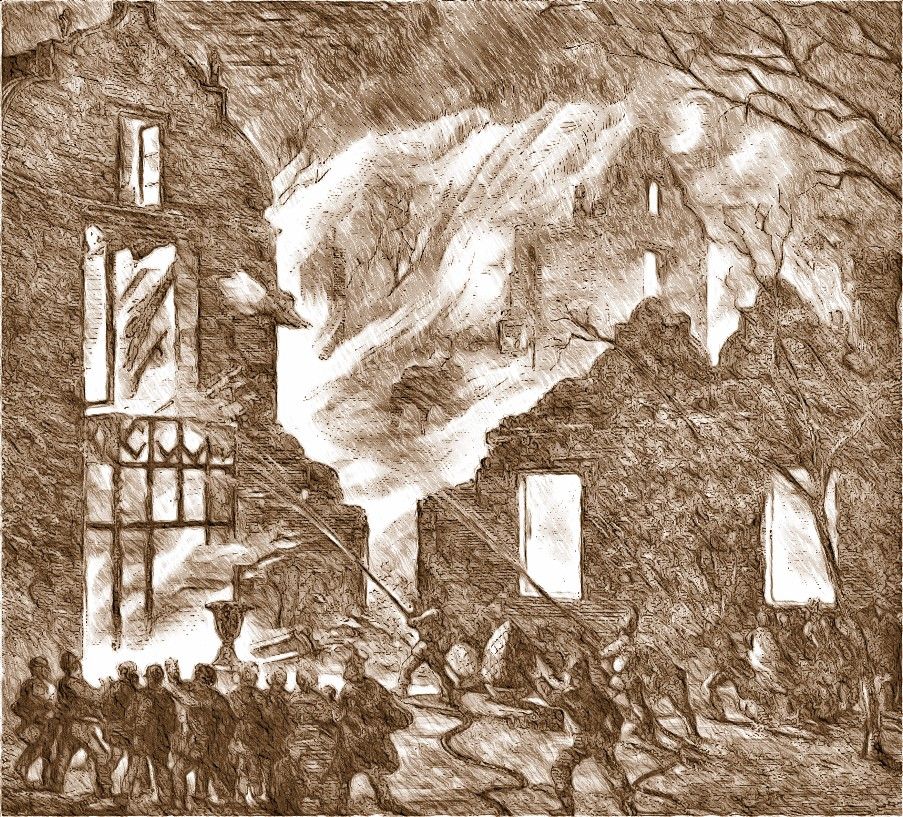
The English Year Almanac
I came across the anniversary of the fire in a secondhand book I picked up. It is by my old boss, Sir Roy Strong. The book is called ‘The English Year’ and is written with Julia Trevelyan Oman. It is described as ‘A Personal Selection from Chambers’ Book of Days’. Last year I also purchased the Chambers book on Abebooks for £ 2.10!). Both have been a useful source of information for my Almanac of the Past.
Sir Roy Strong was the Director of the V&A. Sir Roy is a dapper dresser you might almost call him a neo-Georgian. Certainly, a bit of a dandy. I always thought he resembled Charles 1, one of our most ineffectual Kings. I didn’t really have much contact with him, being a lowly Assistant Keeper at the V&A. But at the one Keepers’ Meeting I did attend he seemed rather ineffectual as the chairman of the meeting. But this is mere gossip! And I mention it to show how wrong one can be, in judging people.
However, when I consider the revival of the V&A under his tenure, my judgement was facile. Sir Roy transformed the V&A. The Museum had been damaged by years of under-investment in the building since WW2. Sir Roy began a campaign to restore the rich and very beautiful old Victorian architecture. The original Victorian Restaurant was transformed. The shop turned into a retail paradise. Generally, the V&A ceased to be dusty and old under his tenure. The wonders of the Victorian Museum shone again with rich and vibrant colours. It reminds me that good leadership is allowing beneficial change to happen. It’s not about the leader being a dynamic leader. It’s about moving an institution positively forward, which Sir Roy certainly did.
On this day
23 March 1769 Born William ‘Strata’ Smith (died 28 August 1839) was an English geologist, created ‘the first detailed, nationwide geological map of any country’. (Wikipedia). He worked in a town just down the road from Chipping Camden, and there is a plaque to him in Stow-on-the-Wold which I will write up at some point.
Aries, the Nose and the King’s Evil March 22nd
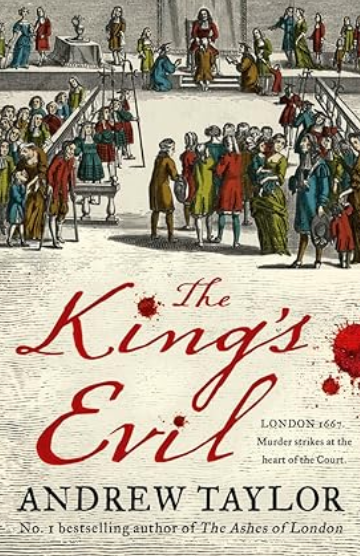
Here is a post on the King’s Evil, that I forgot to post yesterday.
Aries & Noses

We have just entered Aries. Now according to astrology, Aries is associated with health issues of the face. This, according to ‘Skin and Astrology Signs‘ is because of the “level of heat in their bodies”. So Arians tend to have problems such as “flushing, heat rashes, skin eruptions, and rosacea”. They suggest using chilled cucumber for the eyes and forehead, and using beauty products with soothing aloe vera in them.
Charles Kightly, in his Perpetual Almanac enjoins us to ‘Observe the features of the face which are ruled by Aries and seek cures for ills of the nose’.
The first example, Kightly gives is from an 18th Century publication which explains how to understand people by studying their noses:
Nose round with a sharpness at the end signifies one to be wavering of mind; the nose wholly crooked, to be sure unshamefaced and unstable; crooked like an eagle’s beak, to be bold. The nose flat, to be lecherous and hasty in wrath; the nostrils large, to be ireful.’
The Shepherd’s Prognostication 1729
A Fungous Nose & the King’s Evil
The second rather revolting tale is from John Aubrey.
Arise Evans had a fungous Nose and said, it was revealed to him, that the king’s hand would cure him At the first coming of Charles II into St James Park he kissed the king’s hand and rubbed his nose with it: which disturbed the king, but cured him.
John Aubrey Miscellanies 1695. (for more miscellany from Aubrey read my post here.
People believed that Scrofula, could be cured by touching the Monarch. Tuberculous cervical lymphadenitis was, thus, known as the King’s Evil. So, the King or Queen would make herself, very reluctantly, available for his sick public to touch her.
Scofula and the King’s Touch
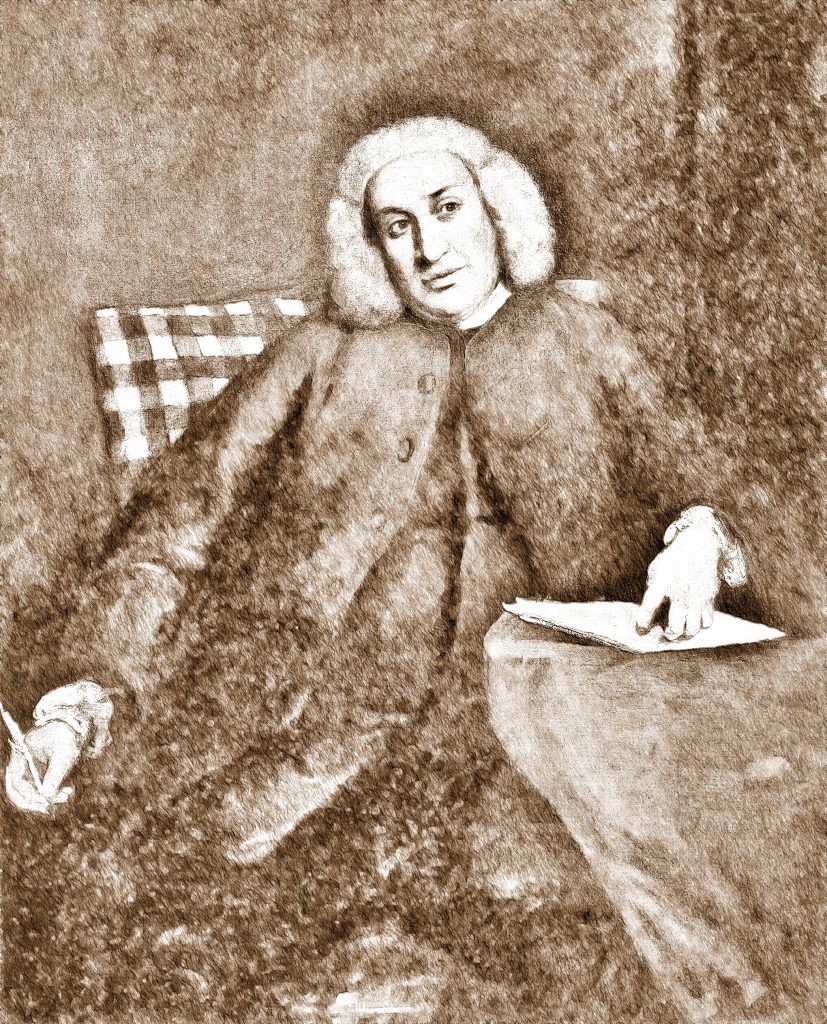
Dr Samuel Johnson suffered from Scofula and received the “royal touch” from Queen Anne on 30 March 1712 at St James’s Palace. He was given a ribbon, which he wore around his neck for the rest of his life. But it did not cure the disease, and he had to have an operation.
It took place in the winter, between Michaelmas and Easter, when cold weather provoked the disease. The lucky few who were allowed the Touch, would be touched or stroked by the King or Queen on the face or neck. Then a special gold coin, touched by the Monarch, was put around their neck. Readings from the bible and prayer finished the ceremony. Before Queen Elizabeth, the Touch was said to cure many diseases such as Rheumatism, convulsions, fever and blindness, but after it was reserved for Scrofula.
Who Started touching for the King’s Evil?
It was only the French and the English who believed the King’s touch could cure people. The French claimed it began with Philip 1 in the 11th Century. The English claimed Edward the Confessor as the first. But this was denied by the French who claimed that the French King of England, Henry 1 introduced it to the English. The practice lasted until George 1 who resolutely refused to have anything to do with it.
For more on the King’s Evil have a look at this blogpost. Or read the book pictured at the top of the post.
First published in 2024, and revised in 2025
The Wandering Cardinal Points & Digital Heritage March 21st

The day after the Equinox we look at the cardinal points of the compass:
“chief, pivotal,” early 14c., from Latin cardinalis “principal, chief, essential,” (online etymological dictionary).
The Importance of South
On its annual cycle, the Sun is always on the move. At the Equinox the Sun now rises due East, and sets due West. It then rises every day further towards the north and sets further to the South until the Solstice. The Solstices mark the extreme Northerly and Southerly rising and settings. Dawn and Dusk vary accordingly.
So, the only real fixed point in the Sun’s entire journey (as seen from Earth) is Noon. Every day of the year, every day of our lives, the Sun is at the highest point at Noon. And this is the definition of South. But the Sun never strays into the North. So the North is the polar opposite of the South- cold, remote, more mysterious, unknowable almost.
To my mind, it makes, of the Cardinal Points, the South very special. At Stonehenge, there are two exits. The biggest is aligned to the Midsummer Sunrise and Midwinter Sunset axis. But there is a smaller second entrance and this aligned due South. There is also a uniquely small standing stone in the main circle of Sarsens, which is aligned to the South. (Although we don’t know if this stone is original). However, there was some sort of corridor heading South through the mysterious wooden phase which precedent the stone Stonehenge. So, we can be fairly sure South was important at Stonehenge.

Noon, derives from ‘nona hora’ in Latin and is ‘one of the seven fixed prayer times in traditional Christian denominations.’ (Wikipedia)
The Predominance of the North?
And yet, North, has come to be the principal of the cardinal points. It is shown on virtually all modern maps. It is the direction that people of my generation and hemisphere think of as being ‘up’.
The Google generation sees things differently. There are countless tourist maps on walls or plinths where North is no longer at the top. Up is shown as being the way you are facing. Users have to fight with Google Maps to put North at the top of the map. My children mock me when I say ‘Out of the Tube station, turn up the High street northwards.’ Their view of maps is completely contextual. They do not see any reason to know where the cardinal points are. I point out that the Tube probably has two exits on either side of the road. So, it doesn’t work to say ‘turn left out of the tube’.
There may also be an element of sexual difference, with men more likely to have a cardinal point view while women navigate more by landmarks. ‘Walk past the M&S, turn left to the Park and straight on’. One paper says: ‘during spatial navigation, women typically navigate an environment using a landmark strategy, whereas men typically use an orientation strategy.’
Although I see this decline of the north as being part of the Decline of the West. I also ‘things were better in my day’. But in fact it is simply returning to the way maps were produced in the past. Here is an example below.
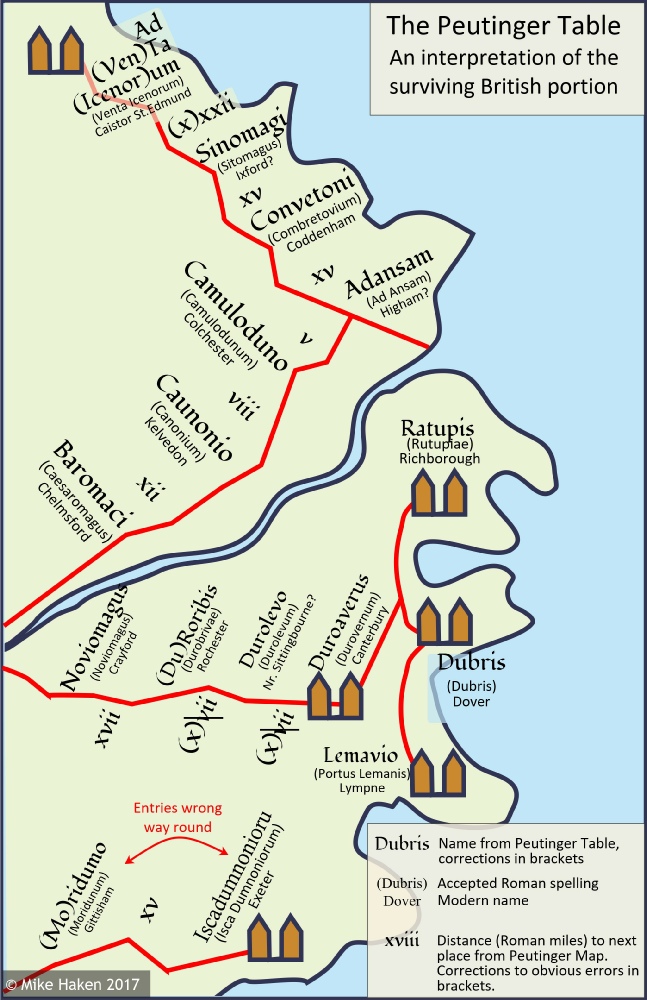
The Magnetic Poles
Of course, there is another version of the cardinal points: the magnetic cardinal points. The magnetic North wanders over time. It does not necessarily coincide with geographic north. In recent times they are close enough. But in the past there have been huge variations. Occasionally, the earth has had geomagnetic reversals when the North Pole has pointed in different directions, including south. The last one was 780,000 years ago. On average, they take place very roughly every 500,000 years.
The magnetic pole is caused by the molten iron in the earth’s core and mantle, which creates a dipole. Fluctuations in the dynamo flow of the molten iron cause occasional reverses. The science is very complicated and, even now, not entirely understood. Is it a random consequence of flow dynamics? Or do external events, like sinking continents, or meteor strikes cause the reversal?

Since the first use of compasses for navigation in the 11th/12th Centuries, the magnetic pole hasn’t wandered enough to be of concern to navigation. It has wondered a few hundred miles over the last 500 years. Now, it is speeding up, from 9km a year to 52km (since 1970). This Wikipedia page is pretty good at an explanation.
My Job Tracking the Cardinal Points
My first proper job after university was as a technician then research assistant at Oxford University studying these phenomena. I say ‘proper’ because when I left University, I became an itinerant archaeologist. This led me to digs in Switzerland, Northampton, East Anglia and Nottingham. Then, I got the job at the Research Laboratory for Archaeology and the History of Art, at Keble College, Oxford.
I worked for Dr. Mike Barbetti who was an expert on the wanderings of the Magnetic Pole. His interest was firstly in the pure science of the subject. But he was keen to explore the applied uses in Archaeology as well. So, after being appointed as a Research Fellow at Oxford, he set up an epic journey from his native Australia to Oxford. It went via some of the iconic sites of Palaeolithic Archaeology, including Olduvai Gorge, Tanzania. The site of excavations by Mary and Louis Leakey.
To plot the movements of the magnetic north, scientists needed dated samples. Early human sites provided dated sites over a long time span. Also, archaeomagnetism, as the discipline became known, offered the possibility of dating sites. Another application was to determine whether deposits were fired or not. One of the sites Mike sampled was a candidate for the first evidence of fire in human existence.
Cutting up Samples
As I said, Mike’s interest was discovering how the magnetic field of the earth changed over time. And, more importantly, what was the mechanism. He shipped back to Oxford samples of soil cast in Plaster of Paris. My job was to cut the samples up. I cut them up with an electric saw in a shed in the backyard of the Laboratory. Then we measured the direction and intensity of the magnetic field in the samples.
Soil contains particles of iron, and they align randomly. So a sample of soil has a low magnetic intensity and a random direction of magnetic field. But once heated up, the iron particles align to the current direction of the magnetic pole. Its intensity is proportional to the intensity of the Earth’s magnetic field. These measurements provide a method of plotting the changes of the magnetic field over time. And from these data, models can be constructed explaining how the iron in the earth’s core worked as a giant magnet.
Once we had built a reference curve for the movements and intensity of the magnetic pole over time, we hoped to develop another dating method. Other methods such as radio carbon, thermoluminescence, and tree ring dating, were being developed at the Research Laboratory in Oxford.
My part in Digital Heritage Part 1
Having got the results, I took them to the Oxford University Computer Centre. There, I typed them up onto machine-readable cards. Added a copy on cards of our computer programme written in Fortran, and gave them to the Computing Staff. The program and data were run through the Centre’s mainframe computer. (probably an IBM or ICL computer, the size of a house!). 24 hours later, I received a print-out to proofread.
I located mistakes, ran an editing run of punched cards, essentially instructing the computer: ‘on card two replace 2.5 with 2.6, and run the programme again’. I would pick up the results 24 hours later. It seems extraordinarily primitive now, but then it was an enormous saving of time.
And that, patient reader, was my early contribution to Digital Heritage and pure science. Mike published many articles of which I was joint author of three articles, two in the prestigious Science Journal Nature. And it is annoying that my citations in the groves of academia are still dominated by articles I co-wrote in the late 1970s/80s!
Mike’s work was important in the development of the study of the earth’s magnetic field. However, the use of archaeomagnetism has never risen above strictly limited. Occasionally, in specific circumstances, it can be useful. But those circumstances tend to be times when no other methods have worked. Most often, it is used in attempting to date kilns.
These are the papers:
Barbetti. M and K. Flude, ‘Palaeomagnetic Field Strengths from Sediments baked by Lava flows of the Chaine des Puys, France.’ Nature, Vol. 278 No 5700. 1979
Barbetti M., Y. Taborin, B. Schmider and K. Flude ‘Archaeomagnetic Results from Late Pleistocene Hearths at Etoilles and Marsangy, France’. Archaeometry 22. 1980
More on my contribution to Digital Heritage in posts to come.
OnThis Day
Duel Day is celebrated when the Duke of Wellington fought a duel against George Finch-Hatton, 10th Earl of Winchilsea, because of disagreement about Roman Catholic Emancipation. The duel was in Battersea Fields on 21 March 1829
First written March 2023, revised 21st March 2024
The Spring Equinox March 20th
So, Spring has sprung, not only meteorologically speaking but also astronomically. We are 20 days into the meteorological Spring which started on 1 March (see my post here.) Today, we are starting the astronomical or solar Spring.
The 20th of March is the Spring Equinox, or Vernal Equinox, midway between the Winter Solstice and the Summer Solstice. The sun has been rising further north each day since December 21st. Today it rises due East, and sets due West. The day and night are roughly equal in length (although by no means exactly). At 9.00am today, the Sun was directly overhead at the Equator.
The term vernal comes from the Latin for Spring, and today is the primavera, the first day of Spring. The Anglo-Saxons originally used the word lencthen (Lent) for Spring. But later adopted the idea of the ‘springing’ of the year when the plants bud. In Middle English, the word Spring is also used for sunrise, the waxing of the moon and the rising tides. These are called spring tides. But also for the sprouting of the beard and the first appearance of pubic hair! Happy Spring Time!
Up to the 15th Century, the English also used the French term ‘prime-temps’ in the sense of ‘first times’. This follows the idea that the year is young, while Winter represents old age. As we shall see, on March 25th, there was also a belief that the world was created in Spring at the Equinox. Jesus was also conceived at this point of the annual cycle. (see my post /march-25th-the-beginning-of-the-universe-as-we-know-it-birthday-of-adam-lilith-eve-conception-of-jesus-start-of-the-year)
Zodiacally, if that is a word, Spring is Aries (brave and impulsive); Taurus (sensual and stubborn), and Gemini (dynamic and talented).
Druids at Tower Hill
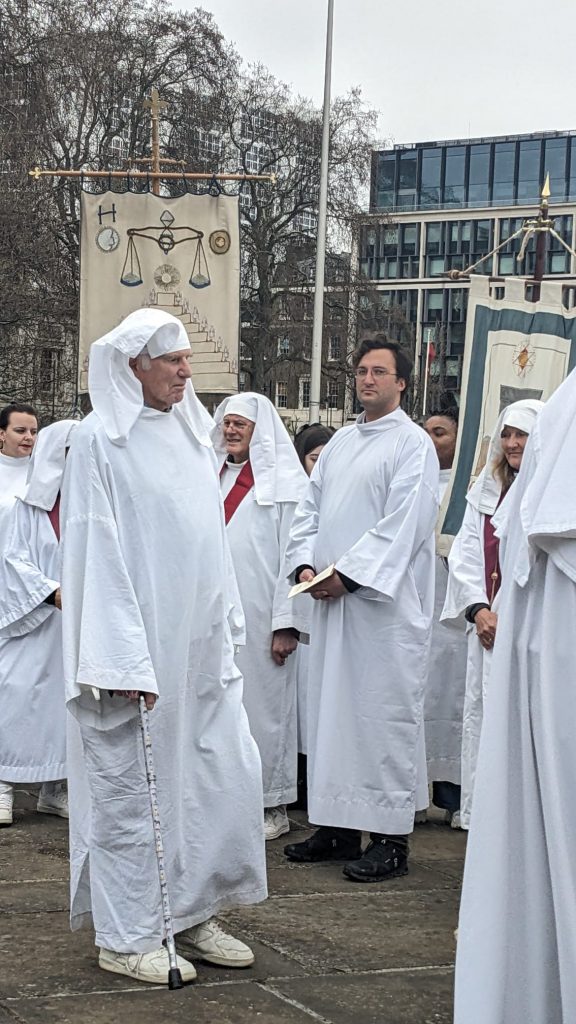
The Druids have a ceremony at Tower Hill every year on the Spring Equinox. When I last attended I remember the druid costumes were often made with nylon sheets, and their footware was mostly tennis shoes. I see from the photos the nylon has at least been replaced with cotton, and the plimsolls with trainers. Not quite sure what that pair of black trainers are doing in the picture!
As my photos are getting long in the teeth, I have used photos by Heike Herbert. She attends most years. The ones above from 2 years ago. She has also been there today. However, she reports that the atmosphere has been affected by a street food market,. This restricted the space for the Druid Circle. The food stalls are there every Thursday, so it only impacts the Druid assembly once every 7 years! I wonder if anything similar happened at Stonehenge?

Modern Druids
I say modern druids because there is no convincing evidence that the modern fellowships of Druids can trace their origins back to prehistory. Druidry was reinvented in the 18th Century — for example, the Ancient Order of Druids was formed in 1781. They were set up as societies in the tradition of the Freemasons. They held to belief in the fundamental importance of nature. However, one group, the British Circle of the Universal Bond, claim descent from a group persecuted by the Bishop of Oxford in 1166. Look at their website for more details and for an idea of their beliefs.
Prehistoric Spring Equinox
When did the Equinox first had importance for human society? The answer is, probably, at least as long as we have been reasoning creatures. On January 14th, I draw attention to a recent discovery by an amateur ‘citizen scientist’. He suggested there was evidence in Cave Painting for the use of a Palaeolithic Calendar. Follow this link to see the post.
Stonehenge and the Sun
At Stonehenge, in the old Car Park, they found three huge Pine post-holes in a line. Dating evidence shows they were erected in the Mesolithic period, thousand of years before Stonehenge. They align to the direction of the Mid-Summer Sunrise and Mid-Winter Sunset (NNE/SSW). If, and it’s a big if, you were sighting from Stonehenge itself, which was built some 5000 years in the future.
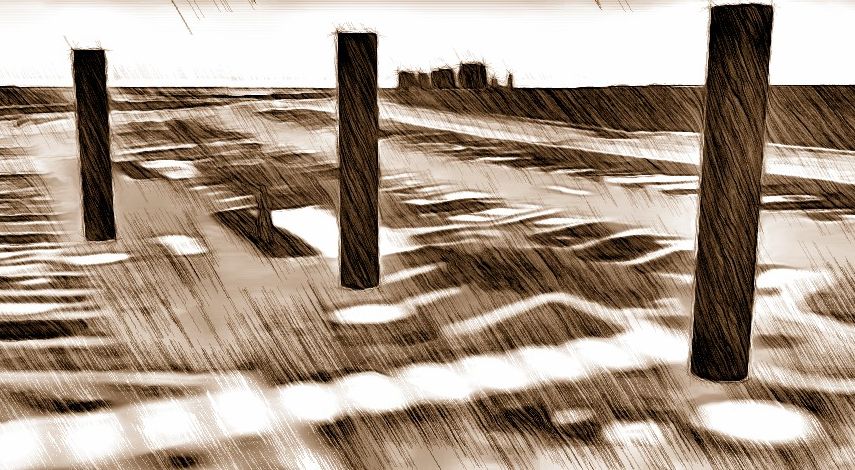
It is a bit of a stretch using two pieces of evidence so far apart in time. But recent excavations have revealed that there are natural periglacial striations in the soft chalk bedrock at Stonehenge. These lines point to the Solstices. They not only predate Stonehenge but also the three post holes. The striations may well have been visible from the time they were created when the glaciers melted.
Around 12,000 years ago (date from my memory so approximate), the climate changed and the glaciers melted. This left a lot of water rushing around the landscape. At Stonehenge, it gouged out striations in the chalk. By chance, or as ordered by the Gods/Goddesses/Divine Nature, the striations pointed to the Solstice Axis. Richard Jacques excavations in the Stonehenge area revealed that the aurochs came to the Stonehenge area for grazing and water. Aurochs are huge wild cows with enough meat on them to feed 200 people. So, the solar axis is near a place where the Gods/Goddesses/Divine Nature provided super-abundance in the guise of herds of Aurochs.
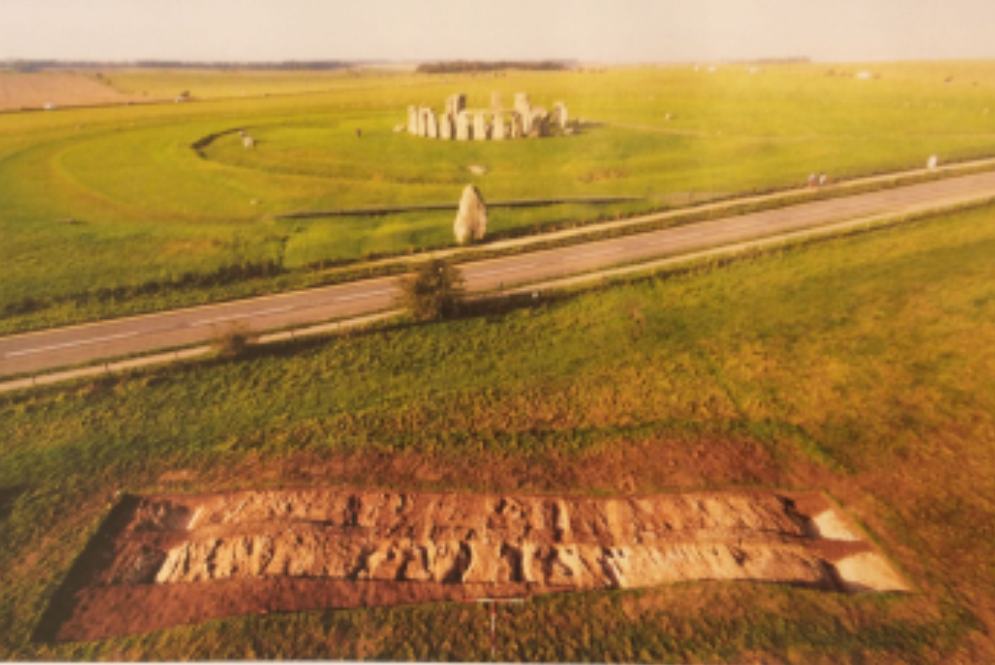
Burial Mounds aligned to the Equinox
This is confirmed by the alignment of many megalithic monuments dating from 3,600 BC onwards, including, of course, Stonehenge. Also, all around the UK are long barrows and other burial mounds, many of which are indeed sited/sited E-W to the Equinoxes. Many are fairly approximate. But at Loughcrew, County Meath in Ireland the Vernal Equinox shines right into the burial chamber. The sun’s light shines onto a stone marked by stone carvings. Similar alignments exist at Knowth and Dowth in the Boyne Valley. More about Loughcrew in my post here)
Harmony & the Spring Equinox.
The Equinox also has another role, which is to be the anchor of the cardinal points. The world is orientated to North, South, East, West. The Equinox is a time when there is a harmony, a balance in the universe. Therefore, it is a fortunate, a lucky time, a time to fall in love or undertake notable undertakings. But, in the Christian world marriage traditionally had to wait a little longer, until after the commemoration of the death of the Messiah,
First Written in March 2023, and revised in March 2024, 2025
Peak Cherry Blossom? March 19th

This year, I don’t think it is yet Peak Blossom. But I’m going to keep this post here to remind you of the joy of the Blossom season. You can plan to visit your local Blossom Hot spot!
Peak cherry blossom is sometime between late March and early April. Last year it was around March 19th, this year maybe a week or two away. There are many suggested places, and I enclose a couple of web links with more details. But my friend, Natalie Tobert, posted last year about Japanese people queuing up to photo cherry blossom in Swiss Cottage.
Here is an Instagram video of the blossom in Swiss Cottage, near Hampstead, London.
Sakura and Peak Cherry Blossom
For the Japanese Cherry Blossom represents both the beauty of life and its brevity. Sakura are honoured by the Samurai, and were on the badges of KamiKazi Pilots in World War 2. The Japanese began their blossom time with Plum Blossom. They can be difficult to tell apart from Cherry but it is much more fragrant. It blossoms earlier.
Cherry trees consist of 430 species in the genus Prunus. Wild Cherry and Bird Cherry are native to the UK. Normal blossom time is April. In mild winters and sheltered places like London they can blossom as soon as February. The flowers are known as Sakura in Japan, and viewing them is ‘Hanami’. Bird Cherry usually flowers in May. Recent blossoming is over 7 days earlier than the average for the previous 1,200 years.
You might like to look at the Natural History Museum discover cherry-trees website. This has more information and suggested places to see blossom.
And here the londonist.com Sakura-in-london-where&when
The Woodland Trust has a great web page about blossom in general and I include their useful table of blossom time, below.

The Trust also have a ‘nature’s calendar’ program. ‘Citizen Scientists’ can participate in projects to track the progress of the sessions in nature.
https://naturescalendar.woodlandtrust.org.uk.
To read about Blossom in Haggerston Park read my post.
First published in 2024, and republished in 2025
Blossom and Haggerston Park March 18th

Last year on March 19th, I declared it was Peak Blossom! This year, it doesn’t seem to be quite that time yet, which is normally in April. However, walking around my local Park Haggerston Park today, I am revising my opinion a little. Haggerston is whitewashed with amazing blossom. I thought it was Blackthorn, until I read that Blackthorn was the tree from which Sloes are grown.
My ‘Flora Incognita’ tells me that it is Cherry Plum, Prunus cerasifera. This makes sense as in the summer, there were people collecting the small plums that were growing on the trees. The pink variety of cherry are not yet at peak blossom. I will post about peak blossom, later today.
I am using this occasion to write about my local park which I have been saving up for a ‘vacant day’. (see my post of Ovid and Vacant days)
Haggerston Park & Park Henges
Haggerston Park was built on the site of derelict houses, a tile manufacturer and a Gas Works in the post war years. The Gas works was situated by the Regent’s Canal with its own basin for loading supplies. In the 80s the Park was expanded to take in some areas which were residential streets. All that really remains of the Gas works are the perimeter walls, and the outline of the canal basin.
The park is a well-loved local facility with green lawns, trees and flowers. It also has a great new playground for kids; astroturf football pitches; tennis courts, toilets, cafe, City farm, and a wild wooded area. This is dominated by the Cherry Plum, trees and is a haven for squirrels. Rats loved it too, but I haven’t seen one for 18 months or so.
The Gardeners obviously like the hengiform design because the Park has a lot of henges, and circuses. I have named most of them.
Snowdrop Henge
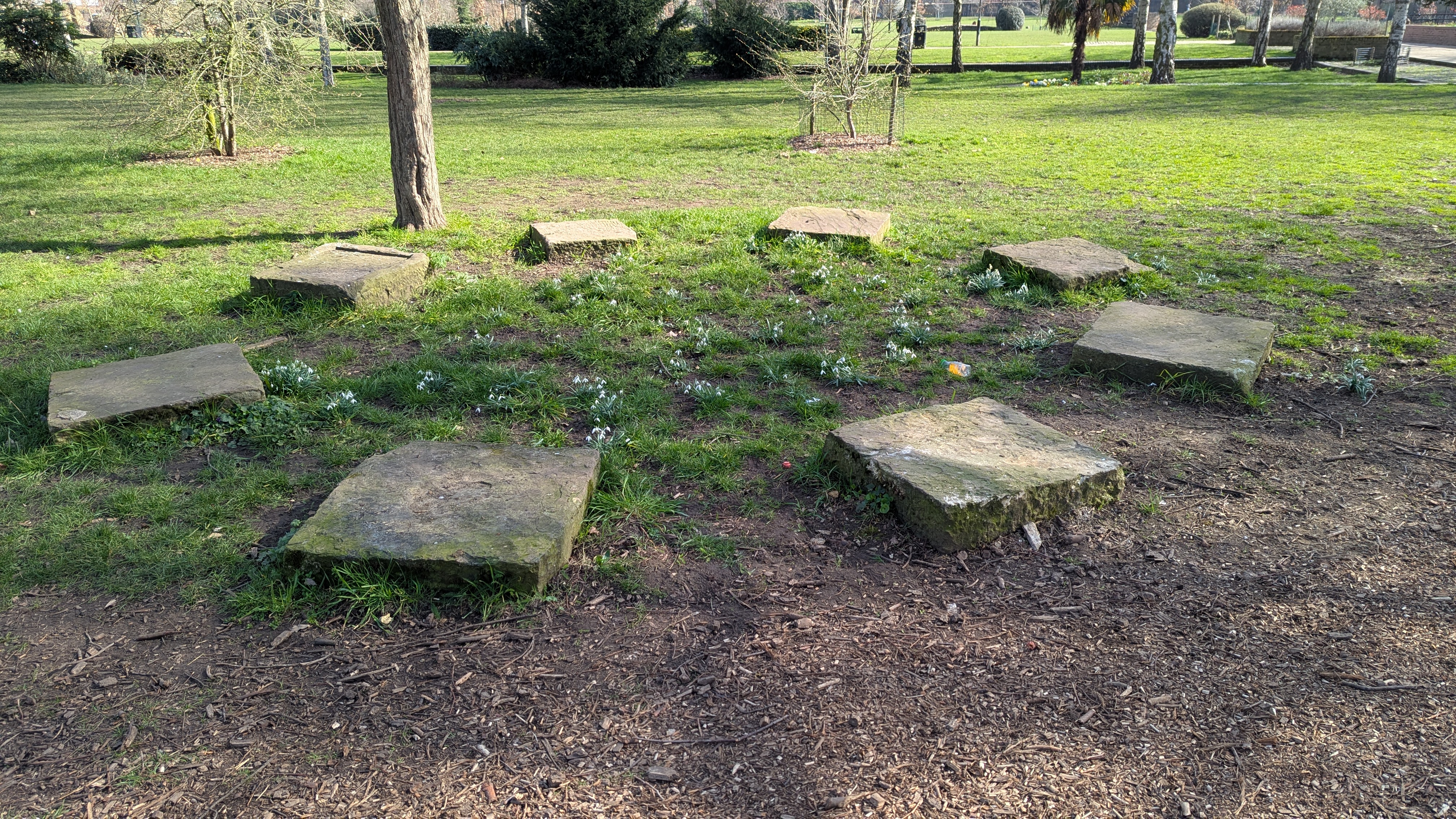
Silver Birch Circle
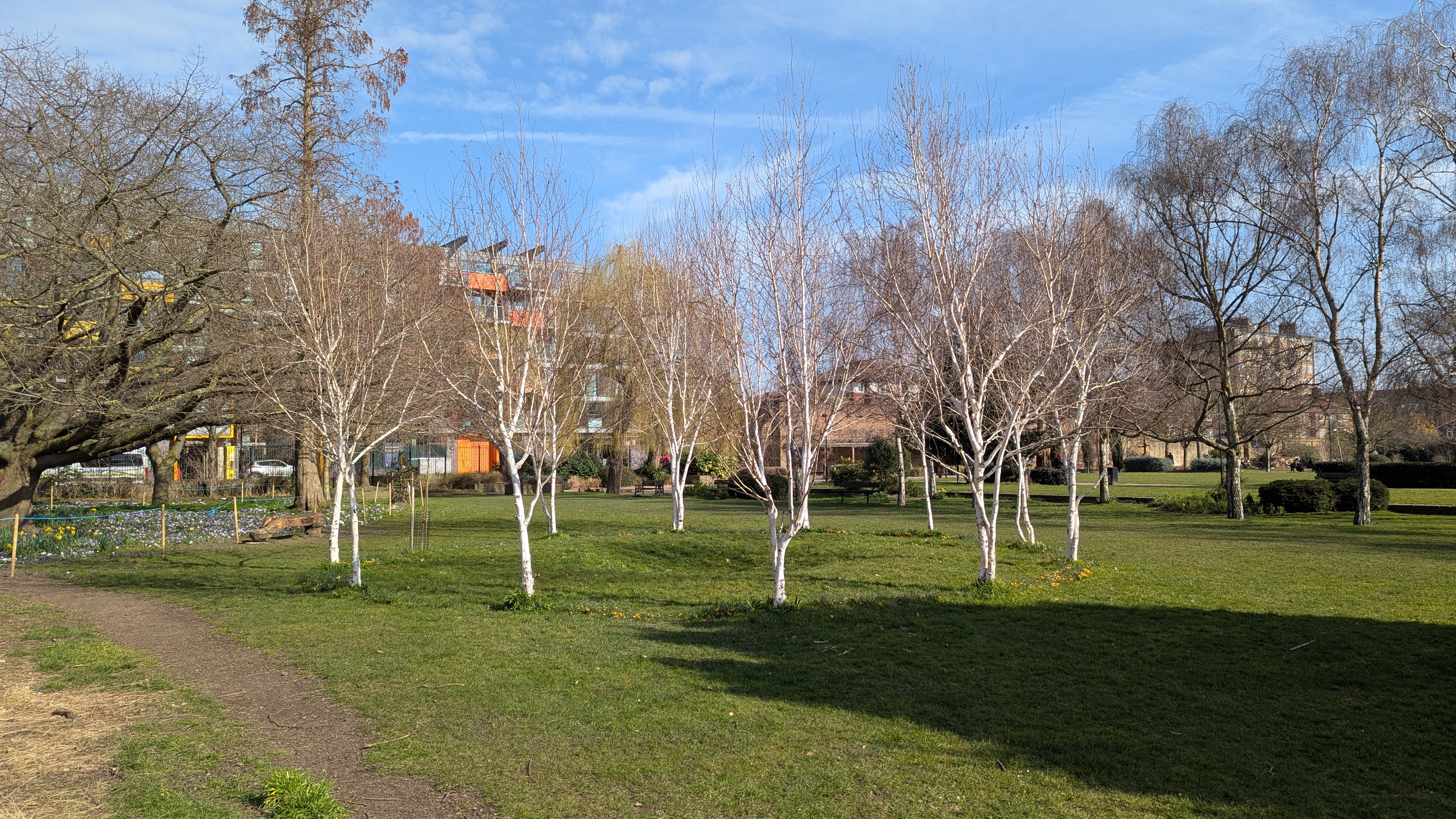
The beautiful croci are not so clear in this picture, but they are really lovely! (See my post on Croci here). Last year I got a better photo of the croci.
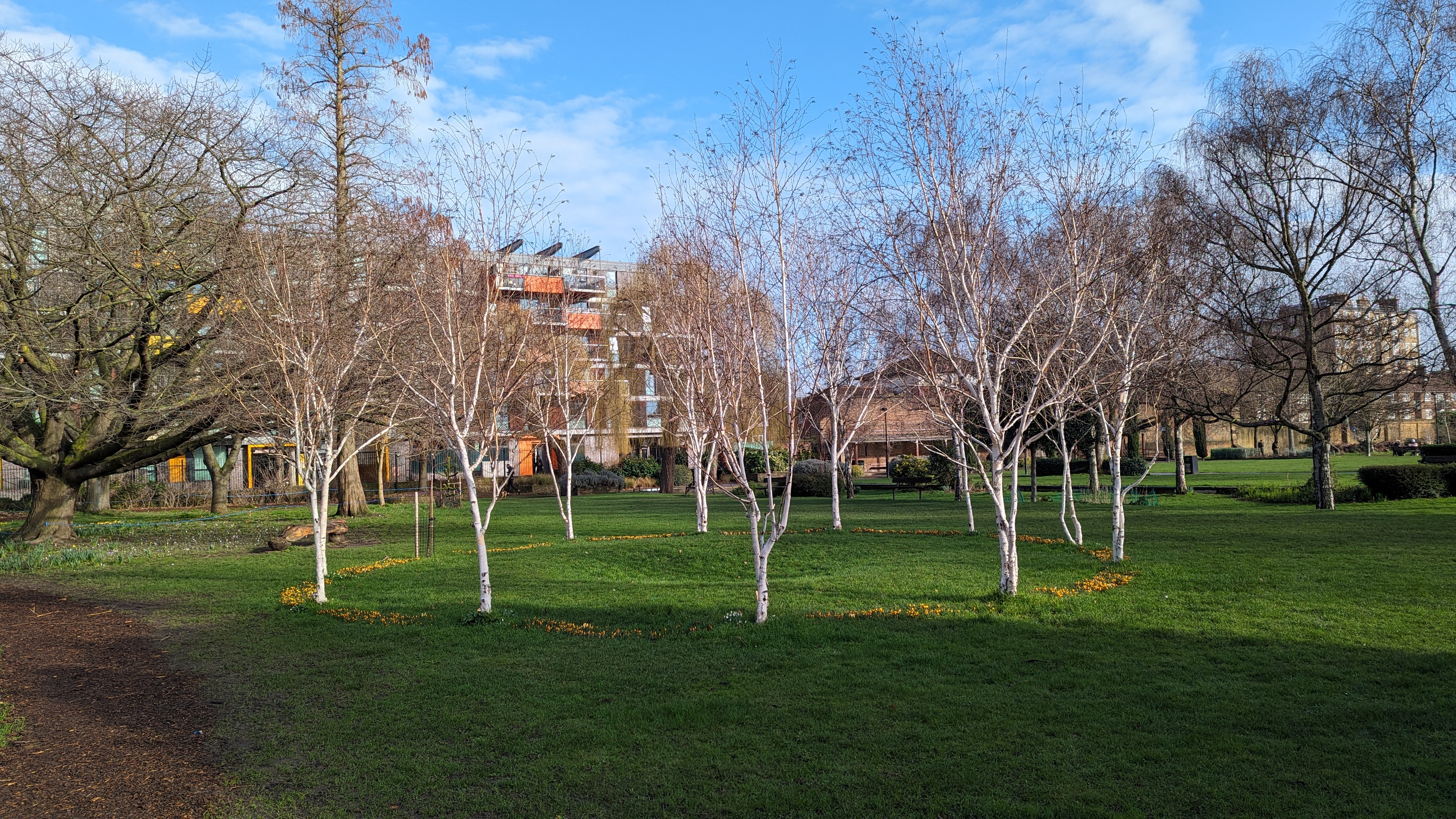
Oak Tree Cluster

This wonderful Oak tree is surrounded by daffodils and croci.

Primula Patch
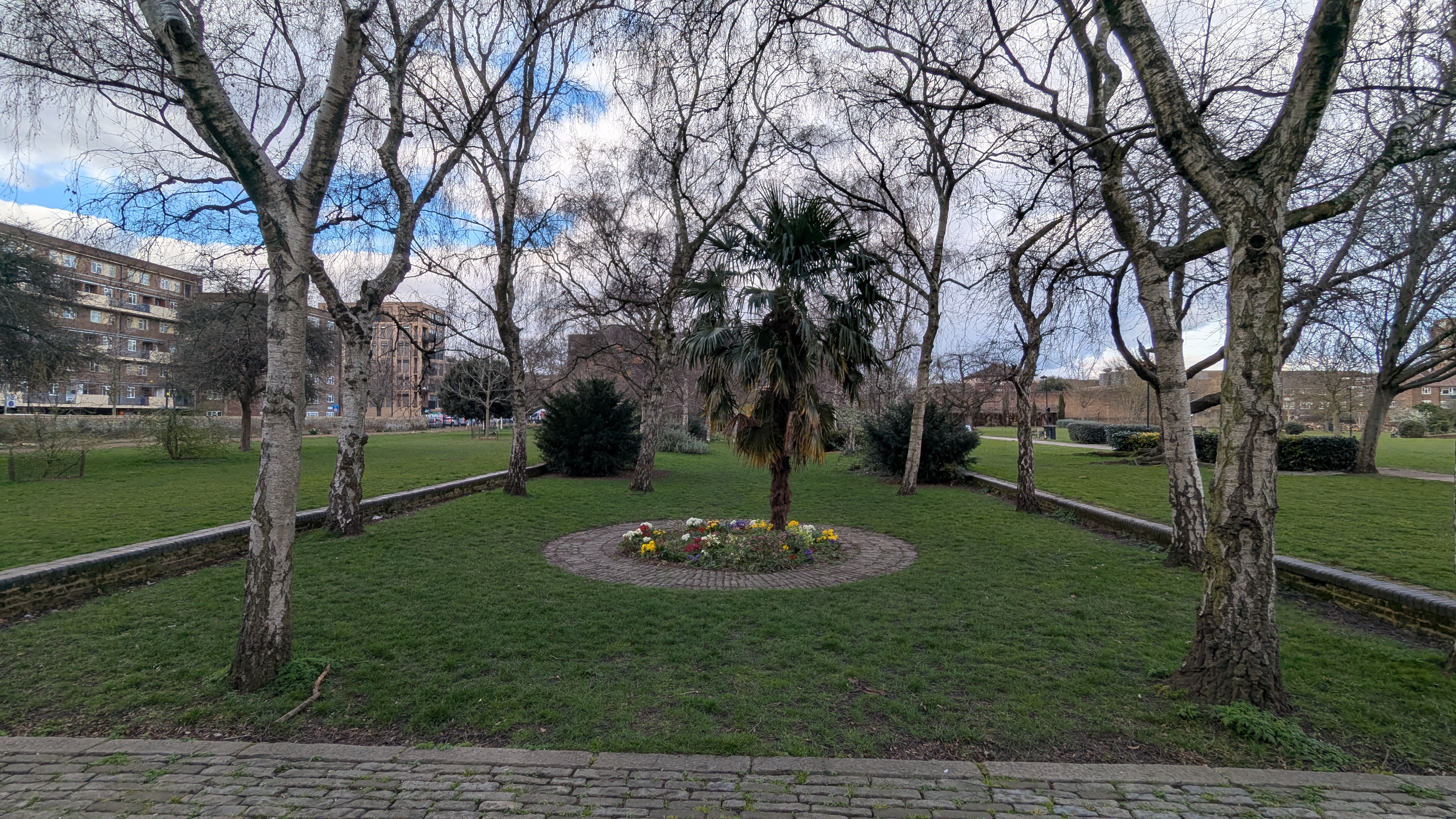
The circle is in the middle of the Basin that connected the Gas Works to the Regent’s Canal. I do hope they are primulas. There is also a lovely circle of Roses.
Gas Works
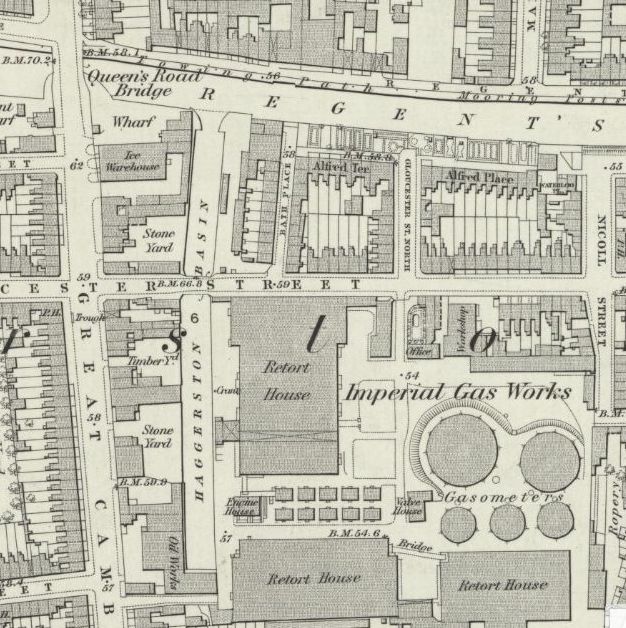
The Park covers the area of the Imperial Gas Works shown above. The photos above of the circles of flowers and trees are mostly in the area of the old Retort House (top left of the Gas works). You might also notice the Ice House, near the top left. (for my post on Ice House please look here).
An earlier map shows the basin leading to the Gas Works from the Canal:
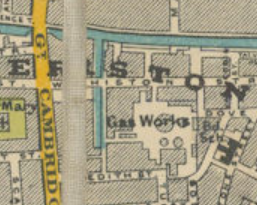
Heron in the Pond, Ancient Wisteria

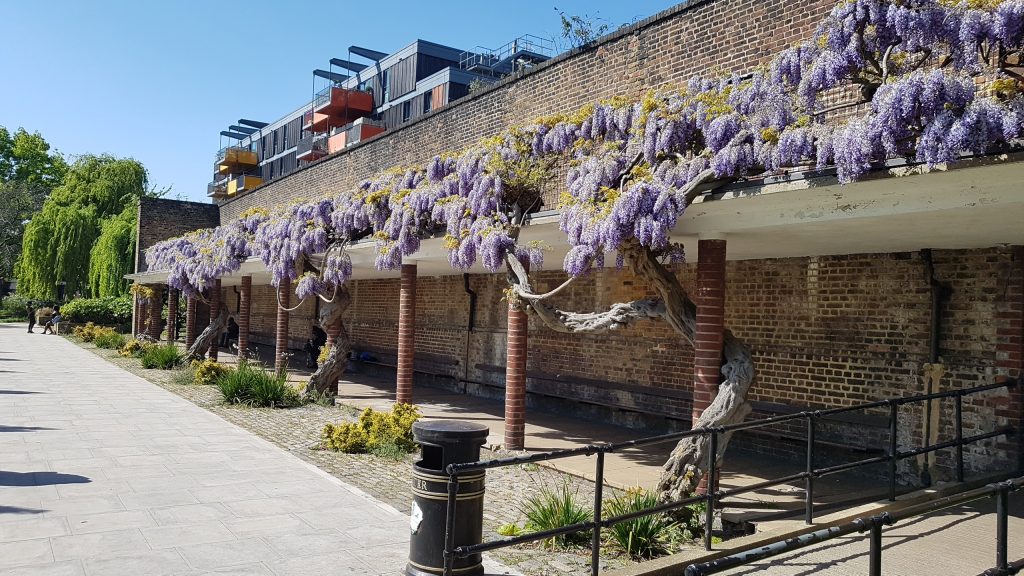
Looking at the maps, it makes it obvious how important the canal was for London’s 19th Century Industry. The whole strip of land on either side was full of factories, warehouses, and basins.
First written on 19th March 2025
